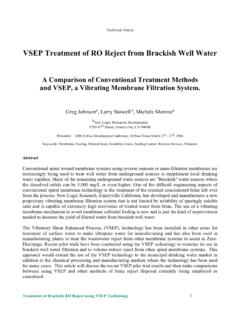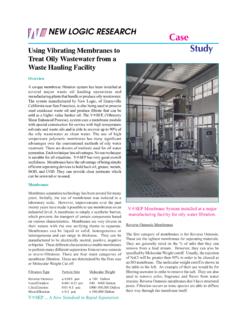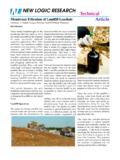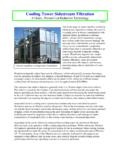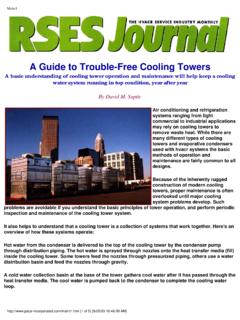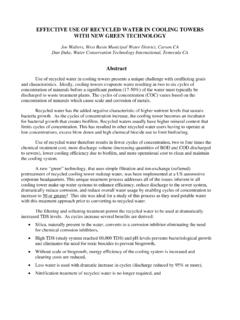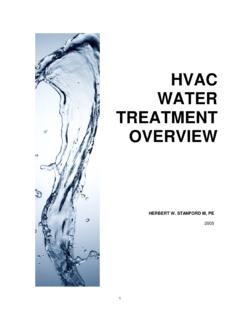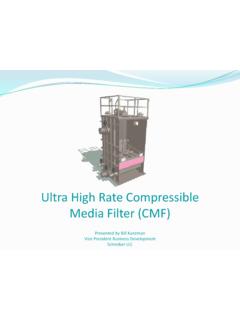Transcription of Cooling Tower Blowdown - Application Note-Final
1 Page 1 Application Membrane filtration of Cooling Tower Blowdown Note Introduction Industries such as refineries, power plants, and chemical plants use evaporative Cooling via Cooling towers for temperature control of the plant's industrial equipment. Waste heat is transferred to a coolant to protect the equipment and to maintain optimum process temperatures. A commonly used type of Cooling Tower is an induced-draft Tower . The hot water is sprayed through nozzles at the top of the Tower which flows through fill media to maximize the contact area with cool air in either a counter-current or cross-flow arrangement.
2 The descending water cools and is collected at the bottom of the Tower before being reused in the Cooling process. Without a Cooling Tower and recycling of the coolant, a constant cool water source would be required and the volume required would not be feasible in most situations. A common source of coolant is ground water. Over time, evaporation occurring throughout the Cooling process will increase concentrations of mineral content in the source water and promote bacterial growth. Build up of dissolved solids, such as calcium, barium, and chloride, can cause mineral scaling and reduce efficacy of Cooling and lead to frequent maintenance issues.
3 Chemical additives help, but cannot provide a complete solution. To maintain efficiency and increase cycles of reuse, a portion of the water is purged when the mineral concentration reaches a set level, typically indicated by conductivity. The purged liquid is referred to as Blowdown . Fresh water called makeup water is added to the process loop to replace Northern California Power Plant Cooling towers the Blowdown and any additional water loss due to evaporation and drift. Wastewater Management The cost of hauling wastewater for offsite disposal can be expensive and in some cases can be environmentally irresponsible.
4 Because the Blowdown contains high concentrations of TDS, it must be treated to meet discharge permit limits. Rather than discharging the Blowdown , a more favorable option is to treat it for reuse. While recycling Cooling Tower Blowdown will improve sustainability metrics anywhere, plants located in areas facing water scarcity challenges can derive even more immediate benefits from reuse. Treatment Options The challenge in treating Cooling Tower Blowdown is the fact that this contaminated liquid is very high in solids. Treatment options for disposal of these liquids such as crystallizers require a large amount of thermal energy, a large footprint, and expensive Page 2 corrosion-resistant materials.
5 Evaporation ponds must be lined and may not be feasible in locations with limited space and low net evaporation rates; furthermore, no water is reclaimed in the process. Wastewater can be collected and treated at offsite facilities when no onsite treatment is available. While hauling requires no upfront capital, it can be much more expensive over time. Hauling costs can also fluctuate wildly depending on the cost of fuel. Discharging to surface water may be an option, but this can lead to large fines when the quality is not within permit limits.
6 Reverse Osmosis membranes are used to separate dissolved ions and produce a high quality permeate. Typical membranes require pre-treatment such as TSS removal, softening, anti-oxidants, and pH adjustment. The clean permeate generated can be reused, but often multiple stages of filtration are required to meet quality standards. The clean water recovery of the RO stage can be as low as 45% and up to 70% for conventional cross flow membranes. Because traditional RO membrane systems are not designed to tolerate high solids, the recovery of clean water is limited by membrane fouling.
7 Many companies are interested in a Zero Liquid Discharge processes (ZLD) and using a combination of the available treatment options, this is a plausible goal. Each approach will have unique requirements and treatment strategies. The VSEP Solution In contrast to the conventional technologies, New Logic Research has developed a unique membrane system called VSEP (Vibratory Sheared Enhanced Process). VSEP also uses membranes to achieve the desired separation, however the difference is that the membrane Page 3 pack is oscillated above a torsion spring that moves the pack back and forth approximately inch at a rate of 54 times per second.
8 This motion is analogous to the agitator of a washing machine but occurs at a much higher speed. The oscillation produces a shear at the membrane surface of about 150,000 inverse seconds (equivalent to over 200 G's of force), which is approximately ten times the shear rate of the best conventional crossflow systems. More importantly, the shear in a VSEP system is focused at the membrane surface where it is cost-effective and most useful in preventing fouling, while the bulk fluid between the membrane disks moves very little. Membranes in the range of microfiltration to reverse osmosis can be Samples taken during Pilot Testing installed on the VSEP and have higher flux and recovery compared to conventional cross flow membranes.
9 Cooling Tower Blowdown can be treated in a single stage of VSEP RO and achieve recoveries of 75-90%. VSEP is able to concentrate beyond solubility limits of Page 4 compounds and operate at economical flux rates due to the benefits of high shear. Similar pre-treatment chemicals used for conventional RO systems such as anti-oxidants and pH adjustment may be required depending on the feed quality, but softening or particulate removal is not required. The permeate from the system can be used for makeup water, boiler feed, or it could be discharged.
10 The concentrate can be sent to disposal wells, hauled offsite, or further treated in an on-site ZLD system. It is common to have multiple sources of wastewater in a single plant. Owing to its versatility, a single VSEP system is often called upon to separate disparate wastewater streams such spiral RO reject, boiler Blowdown , and storm drain runoff, thus increasing its operational value tremendously. The VSEP system is modular and can be used for a wide variety of process flow rates. Modularity also allows for convenient expansion. Every system is custom-built and engineered by New Logic Research to meet each client s needs.
